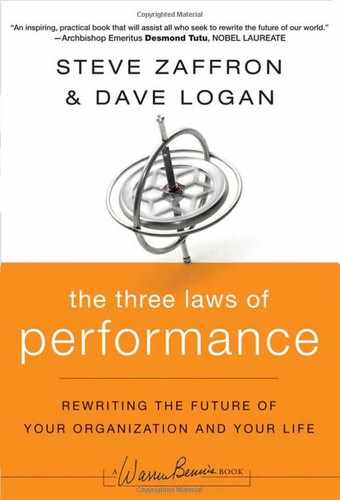[1] Martin Corboy and Diarmuid O'Corrbui, "The Seven Deadly Sins of Strategy," Management Accounting 77, no. 10 (1999): 29–33.
[2] Vincent Pellettiere, "Organization Self-Assessment to Determine the Readiness and Risk for a Planned Change," Organization Development Journal 24, no. 4 (Winter 2006): 38–44.
[3] Helen Keller, My Religion (New York: Doubleday, 1928), 20–21. Helen Keller quotation from My Religion, courtesy of the American Foundation for the Blind, Helen Keller Archives. Used with permission.
[4] Helen Keller quoted in D. B. Updike, Optimism (Boston: Merrymount Press), 13.
[5] This section draws on work from John R. Searle and John L. Austin, in Speech Acts (Cambridge, UK: Cambridge University Press, 1969) and How to Do Things with Words (Cambridge, MA: Cambridge University Press, 1969), respectively.
[6] This section draws on work from Werner Erhard, Michael C. Jensen, and Steve Zaffron, "Integrity: A Positive Model That Incorporates the Normative Phenomena of Morality, Ethics and Legality,", Harvard Business School NOM Working Paper no. 06–11 (April 25, 2008). Available at http://ssrn.com/abstract=920625.
[7] This section draws on material from "The World Is Your Stage: The Workshop Where Being Meets Acting," a course developed by Werner Erhard and Sanford Robbins.
[8] Charles M. Schwab, Succeeding with What You Have (Century, 1917; repr., New York: Cosimo Classics, 2005), 39–41.
[9] The focus of this chapter is organizations, which can be either for-profit or non-profit. They include institutions, governments, and NGOs, as well as conglomerates, multinationals, even start-up ventures. Corporations are easy to discuss in their legal structure, but the issues they face are faced by organizations of all kinds and sizes. The discussion is just as relevant to newer forms of organization, such as limited liability companies and partnerships.
[10] The question of whether animals experience these aspirations often comes up at this point. In this discussion, it's enough to say that even if they experience love, they can't express it as we can, nor can they label their experience "love." Without the word intermingled into the experience, the experience itself is not the same as ours. It is thus safe to say that our experience of love—and by extension, family, relationships, community, and joy—is uniquely human, and exists by virtue of our language-using nature.
[11] The idea of a selfled organization draws its influence, in part, from Warren G. Bennis, "Toward a 'Truly' Scientific Management: The Concept of Organizational Health," General Systems Yearbook 7 (1962): 269–82; from the workplace democratization movement, especially Stanley Deetz's Democracy in an Age of Corporate Colonization: Development in Communication and Politics of Everyday Life (Albany: State University of New York Press, 1992); and from the self-design literature within organizational development, especially Mohrman and Cummings' Self Designing Organizations: Learning How to Create High Performance (Reading, MA: Addison-Wesley, 1990).
[12] Cox, La Caze, and Levine, Stanford Encyclopedia of Philosophy (originally published April 2001, revised August 2008), http://plato.stanford.edu/entries/integrity/.
[13] Erhard, Jensen, and Zaffron, "Integrity" (2008) (see n. 6).
[14] This is not a new idea. Similar threads run through the works of major philosophers and psychologists, especially in the twentieth century. Of these, Carl Jung spoke most clearly on the subject; Jung described "coming to selfhood" or "self-realization" as the final step in one's development. According to Jolan Jacobi, in Psychology of C. G. Jung (London: Routledge & Kegan Paul, 1942), 127, this process results in "an entirely different attitude toward, and view of, life—in other words a 'transformation' in the fullest sense of the word."
[15] This idea draws part of its inspiration from "Stage Five" cultures. See Logan, King, and Fischer-Wright's Tribal Leadership: Leveraging Natural Groups to Build a Thriving Organization (New York: HarperCollins, 2008).
[16] Some of the information in this section is adapted from "The Ontological Foundations of Leadership and Performance," a course at the Simon School of Business at the University of Rochester, offered in 2006, 2007, and 2008.
[17] Douglas Niles and Michael Dobson, Fox on the Rhine (New York: Macmillan, 2002), 312.
[18] Wilbur Smith, River God: A Novel of Ancient Egypt (New York: Macmillan, 1995), 379.
[19] Kenneth Burke, Language as Symbolic Action: Essays on Life, Literature, and Method (Berkeley: University of California Press, 1968), 114–125. Note: we are taking some liberties with Burke's idea, combining it with aspects of brain science—especially Jeff Hawkins and Sandra Blakeslee, On Intelligence (New York: Macmillan, 2005)—and cognitive psychology. Some of what we write was drawn from Appendix B in Logan, King, and Fischer-Wright, Tribal Leadership, and three working papers on SSRN by Dave Logan and Halee Fischer-Wright mentioned in that source.
[20] Hawkins and Blakeslee, On Intelligence, 49.
